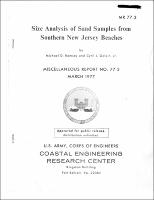Please use this identifier to cite or link to this item:
https://hdl.handle.net/11681/5141| Title: | Size analysis of sand samples from southern New Jersey beaches |
| Authors: | Ramsey, Michael Galvin, Cyril J. (Cyril Jerome), 1935- |
| Keywords: | Beach Fills Coastal Engineering Size Analysis Sand Southern New Jersey |
| Publisher: | Coastal Engineering Research Center (U.S.) Engineer Research and Development Center (U.S.) |
| Series/Report no.: | Miscellaneous report (Coastal Engineering Research Center (U.S.)) ; no. 77-3. |
| Description: | Miscellaneous Report Abstract: The size of sand on Atlantic coast beaches of southern New Jersey was studied by analyzing 788 sand samples. In north-to-south order, the samples were collected at Island Beach, Long Beach Island, Brigantine, Atlantic City, and Ludlam Island. Sand size generally decreased from north to south, with size at the two northernmost sites noticeably coarser on the average than the size at the three southern sites. Results from Long Beach Island, Atlantic City, and Ludlam Island, where most of the data were collected indicate that size, averaged by beach, decreases from 0.33 millimeter at Long Beach Island in the north, through 0.27 millimeter at Atlantic City, to 0.23 millimeter at Ludlam Island in the south. Size, averaged by profile line, varies from 0.34 millimeter at a profile on the northern half of Long Beach Island, to 0.20 millimeter at a profile in the middle of Ludlam Island. Size also varies with position across the profile from low tide terrace to landward edge of berm, tending to decrease landward across the average of three profiles on Atlantic City and three profiles on Ludlam Island, but tending to increase landward across the average of four profile lines on Long Beach Island. Maximum variation at one beach, averaged by position on profile, occurs at Long Beach Island where the average size increased from 0.28 millimeter on the low tide terrace to 0.36 millimeter on the berm. Size variation by month suggests a tendency for sand to be finer during late summer and early fall, but data do not permit identification of a consistent annual cycle. Maximum variation at one beach over the entire sampling period occurred at Ludlam Island, where size increased from 0.19 millimeter in October 1968 to 0.27 millimeter in March 1969. When classified by month or by position on profile, size at Atlantic City tends to increase when size increases at Ludlam Island, 19 miles to the south, and to decrease when size increases at Long Beach Island, 23 miles to the north. The results in this report provide site-specific engineering data for New Jersey beaches, and suggest ways to improve beach fills at these sites. |
| Rights: | Approved for Public Release, Distribution is Unlimited |
| URI: | http://hdl.handle.net/11681/5141 |
| Appears in Collections: | Miscellaneous Report |
